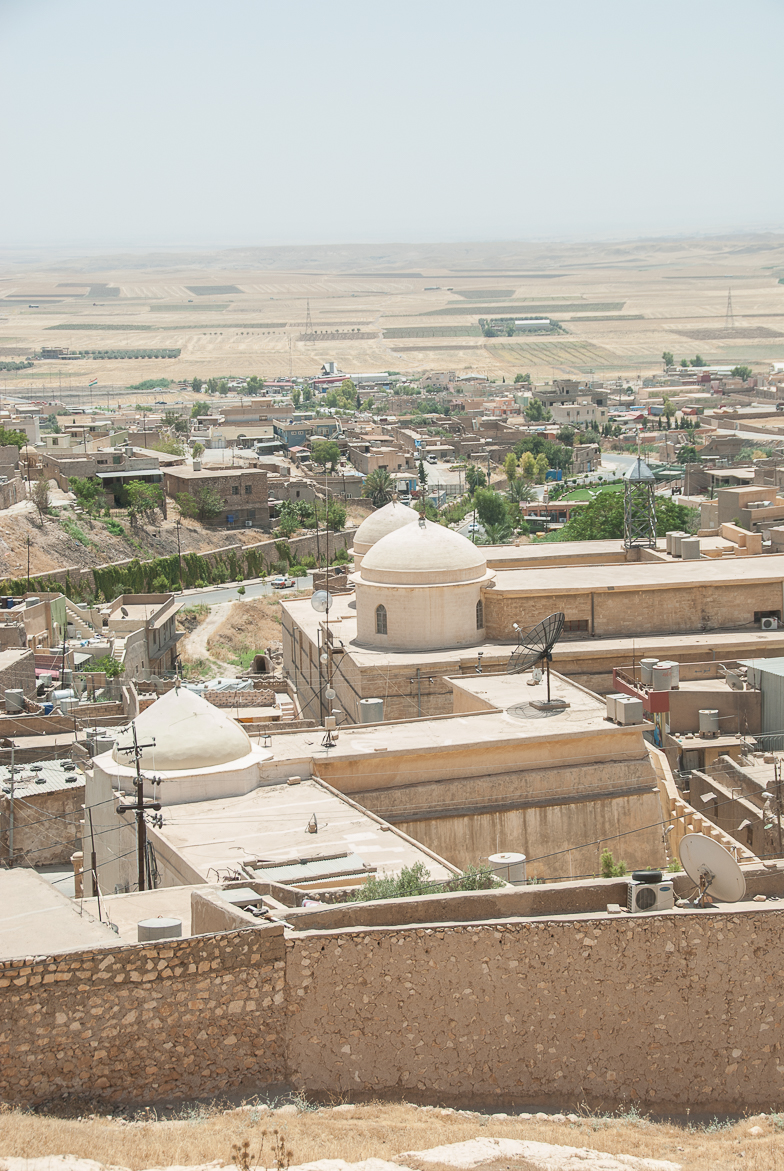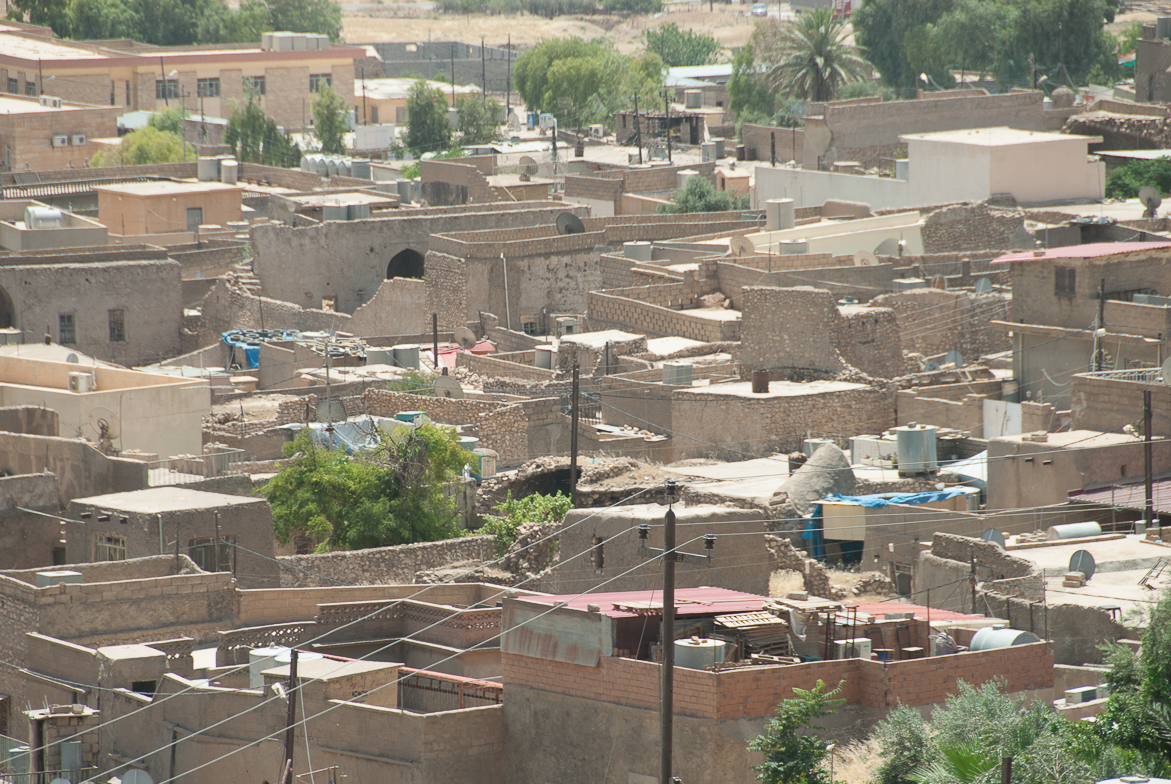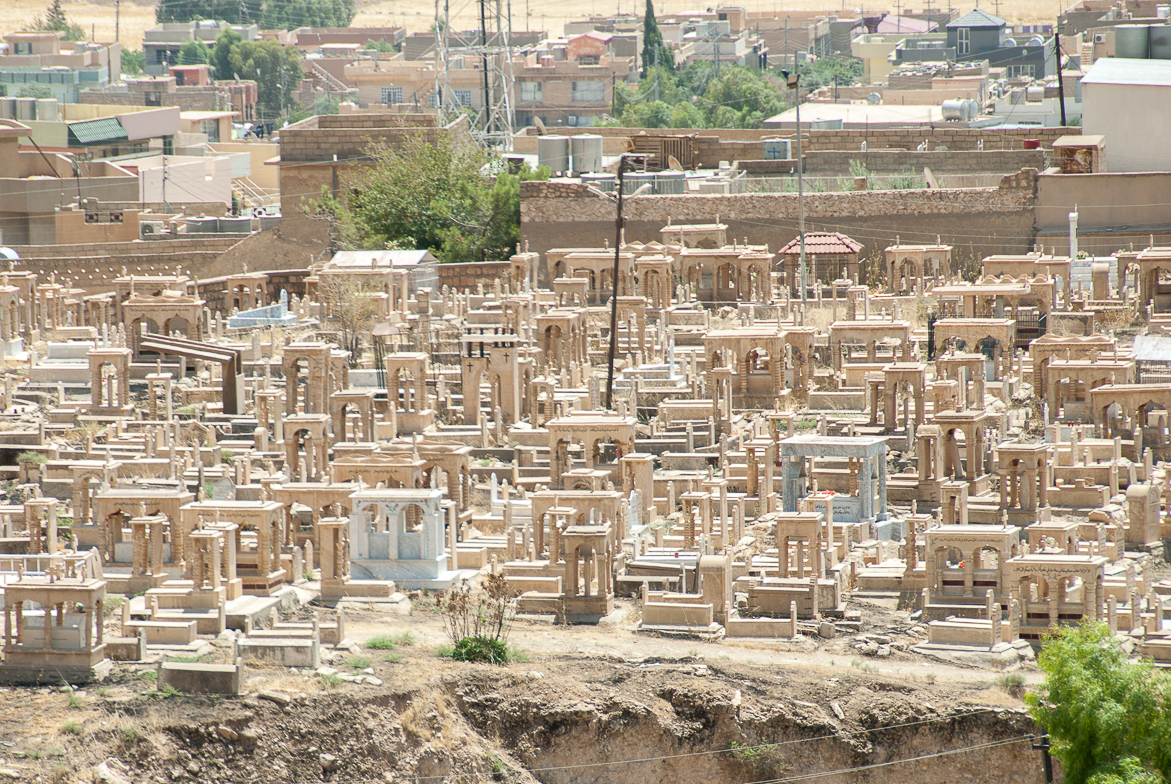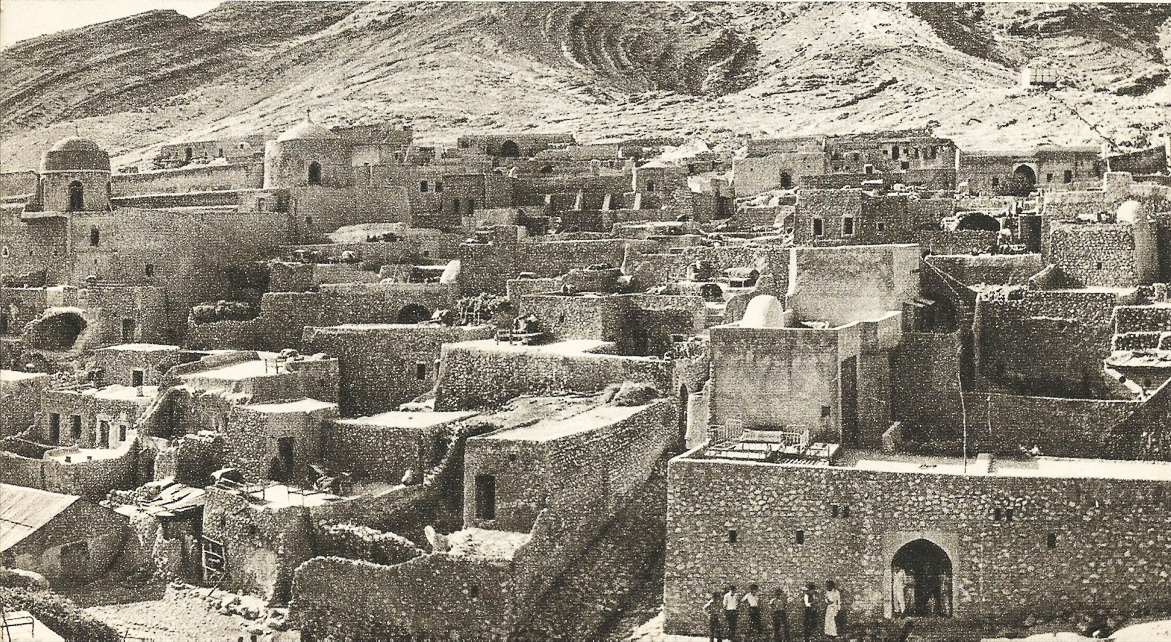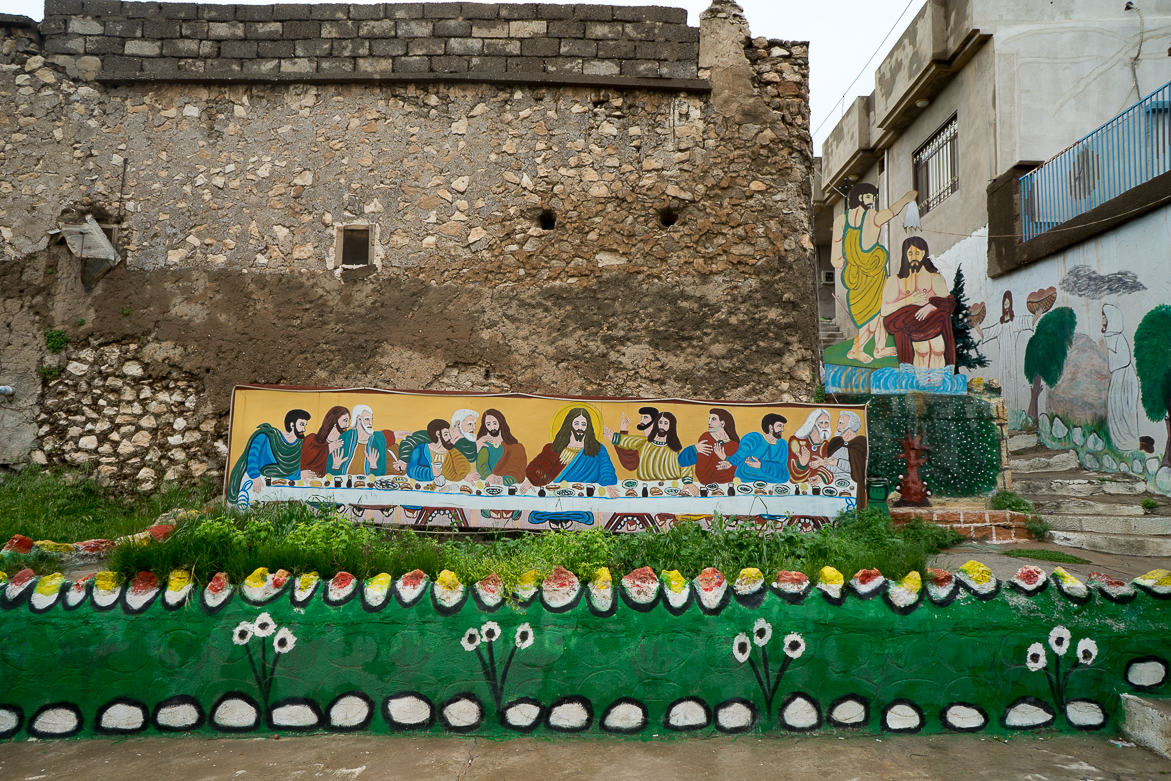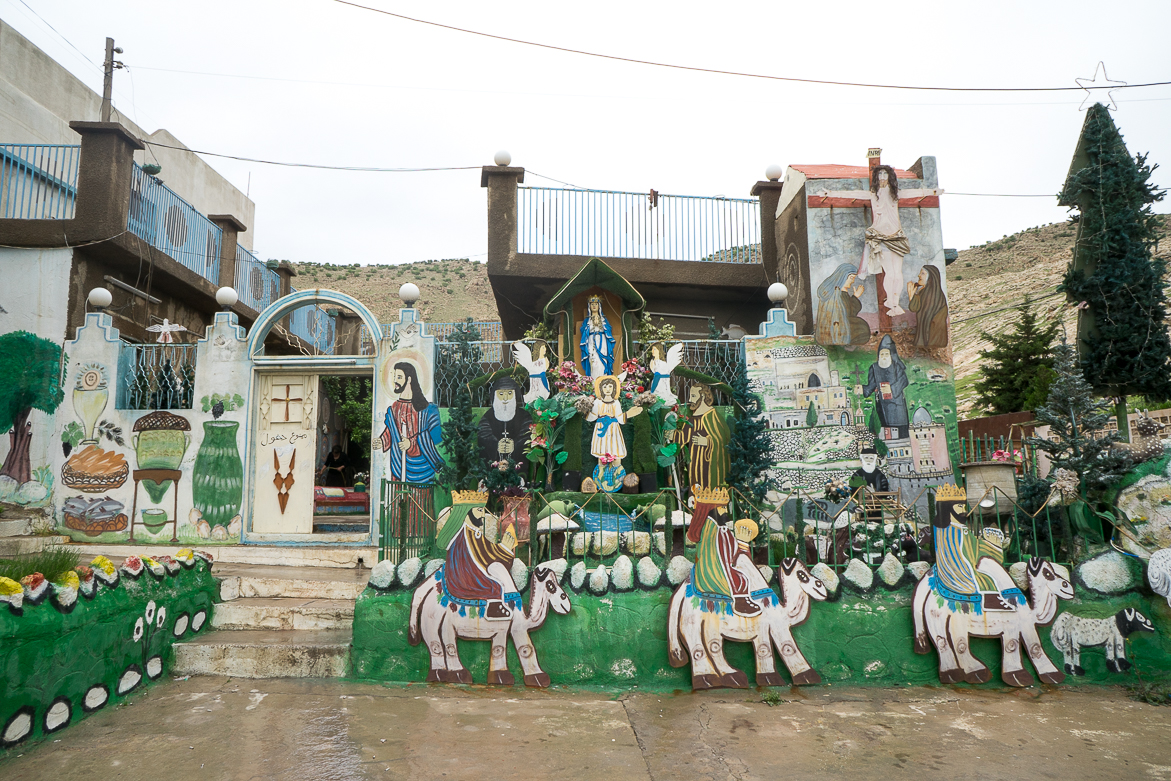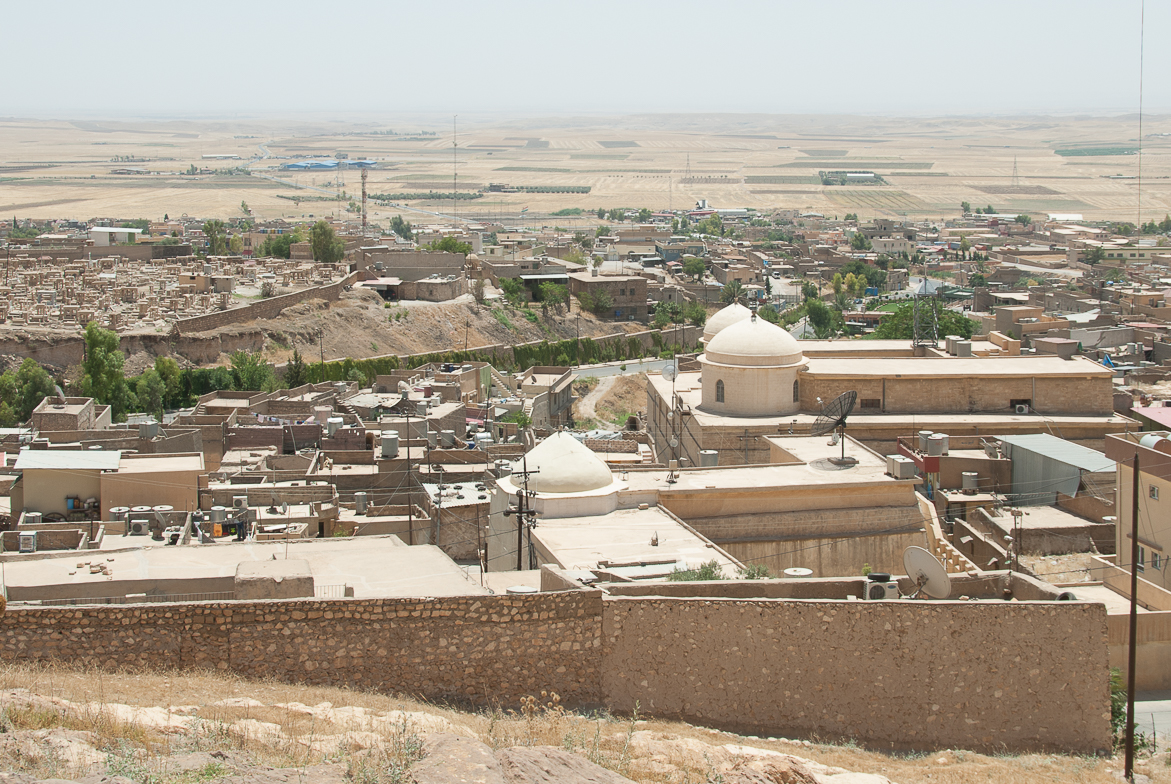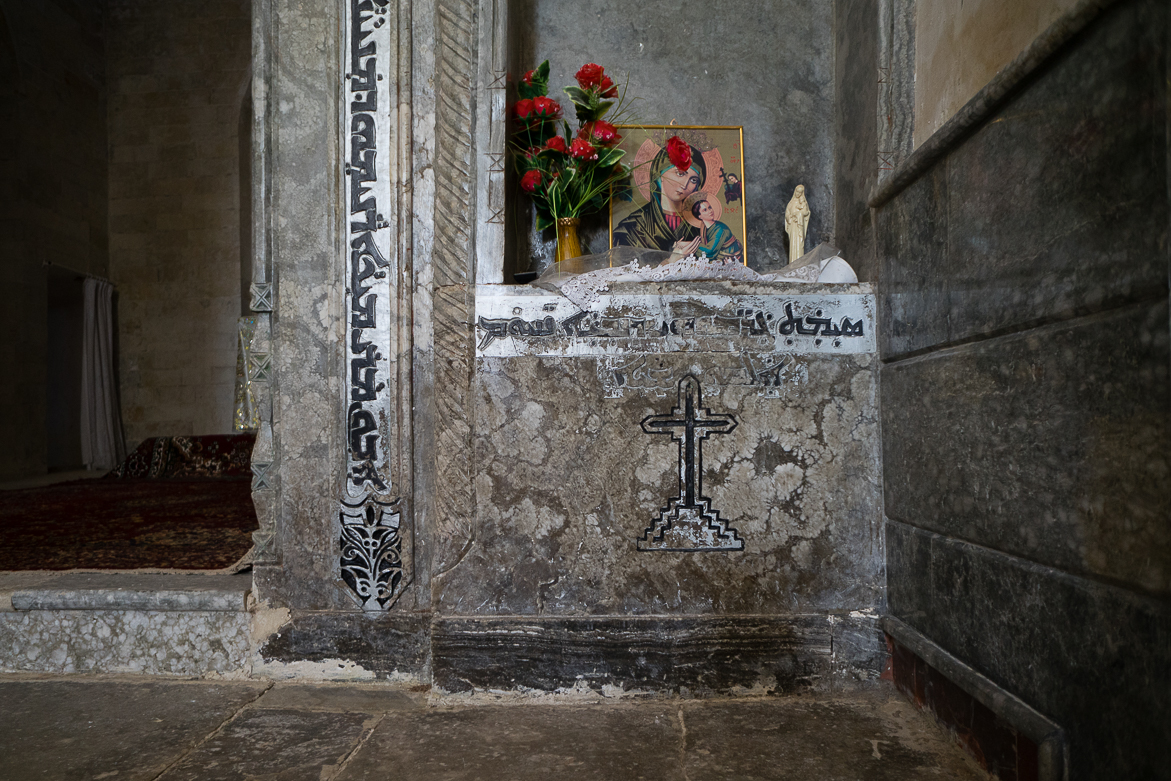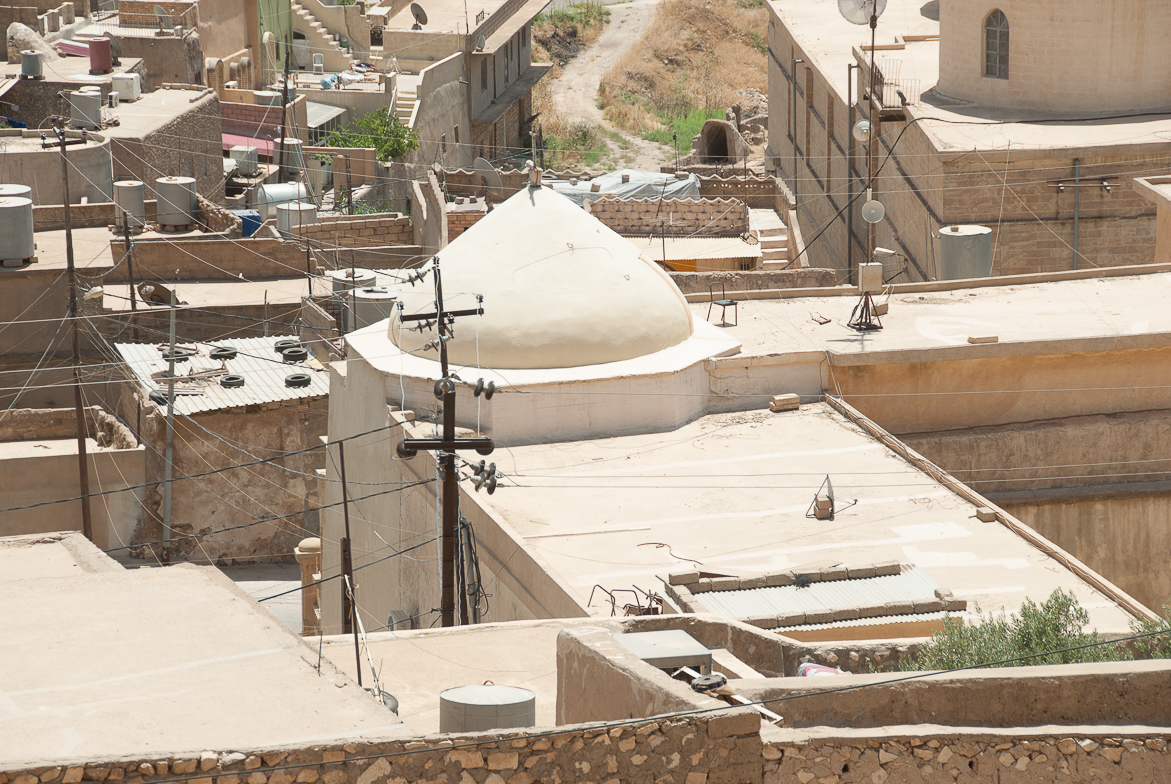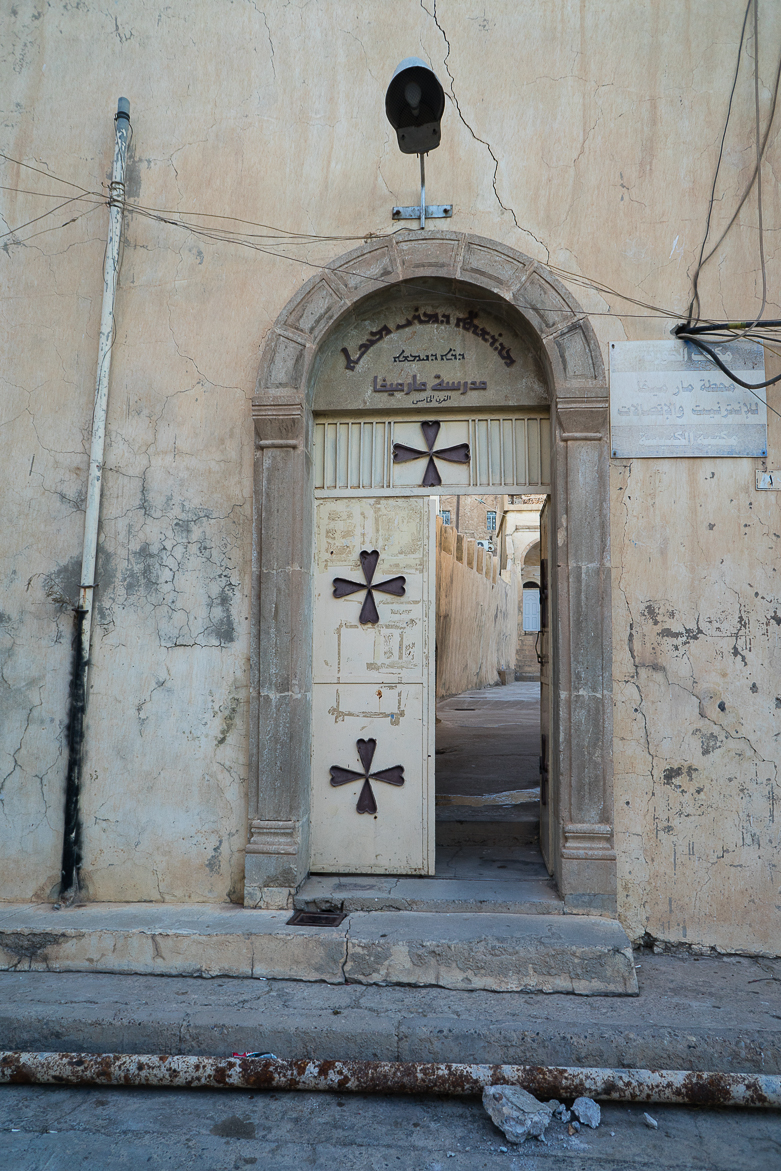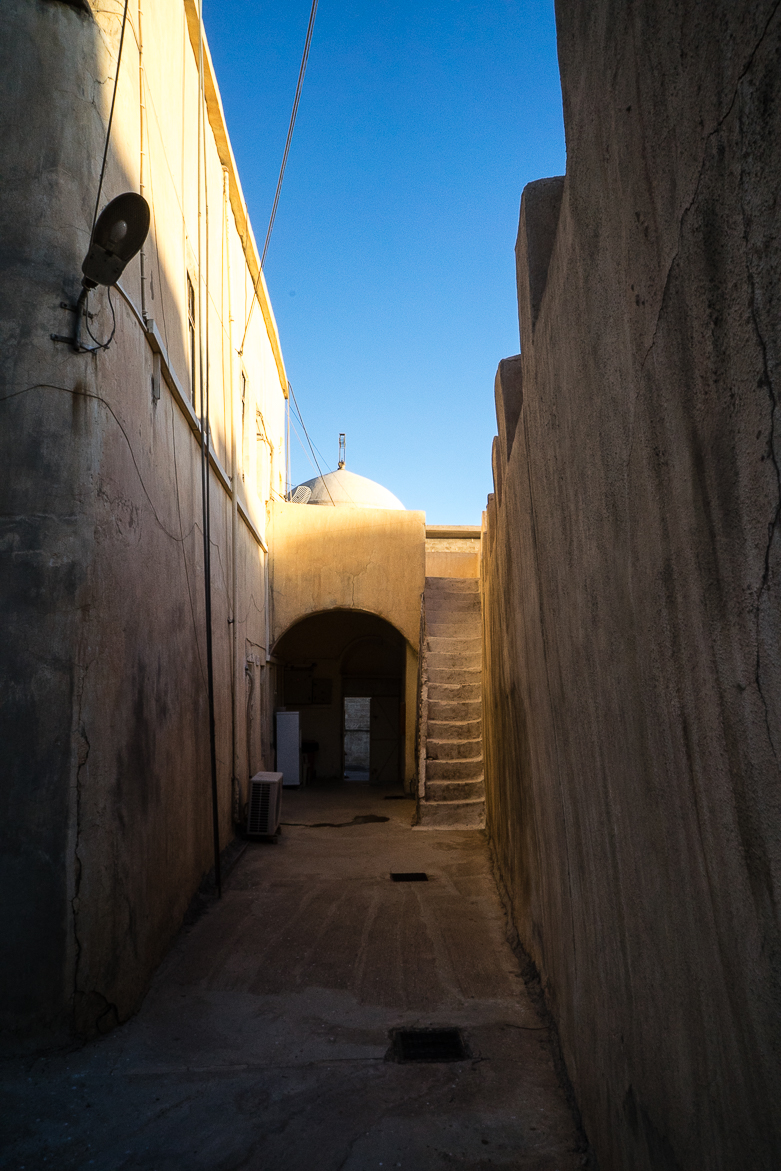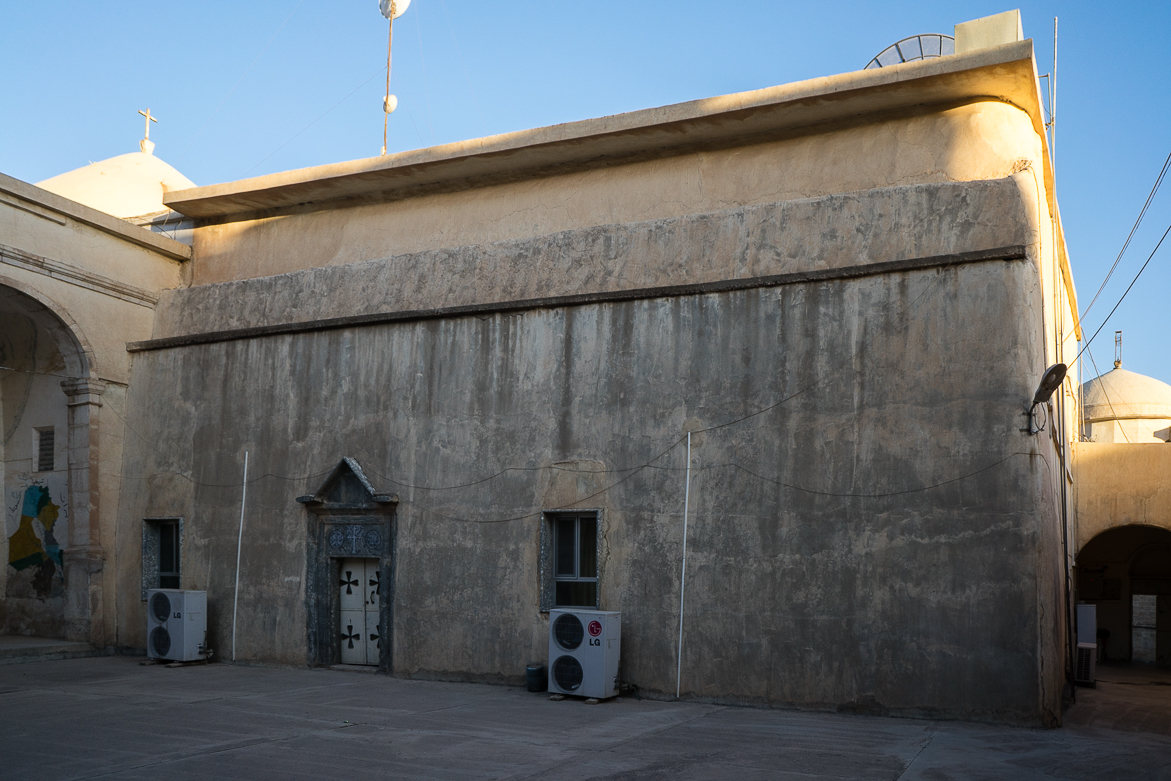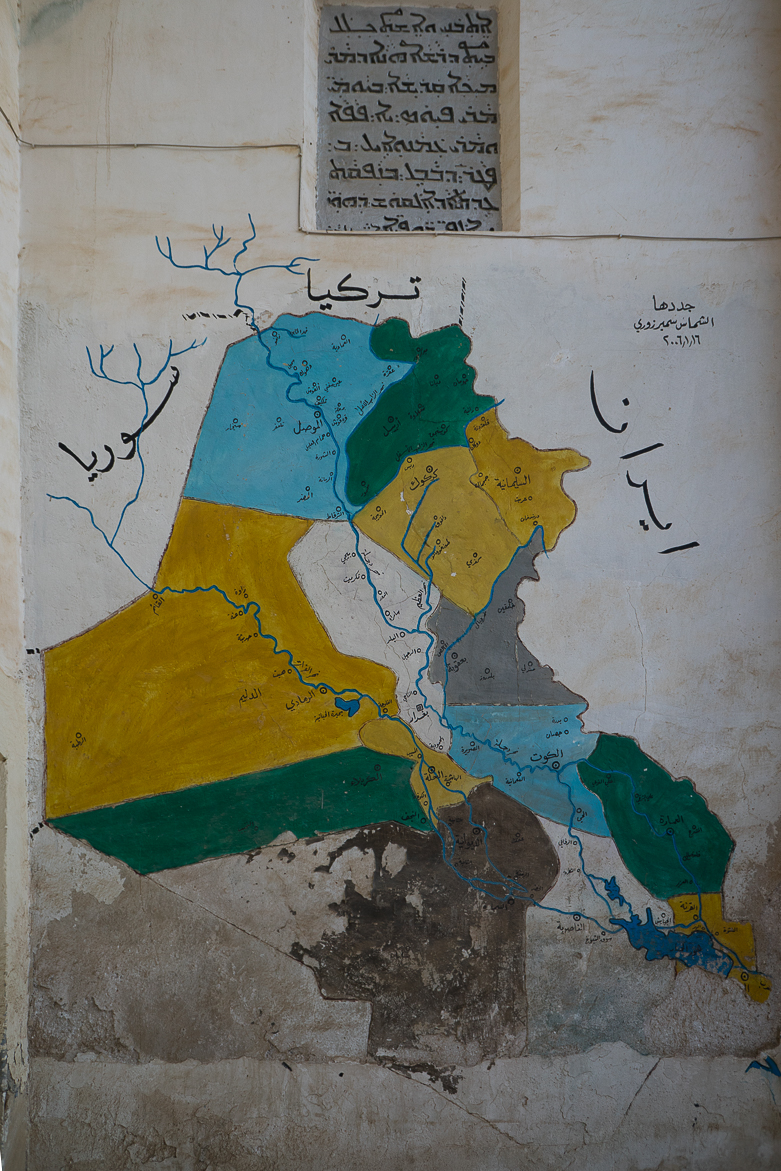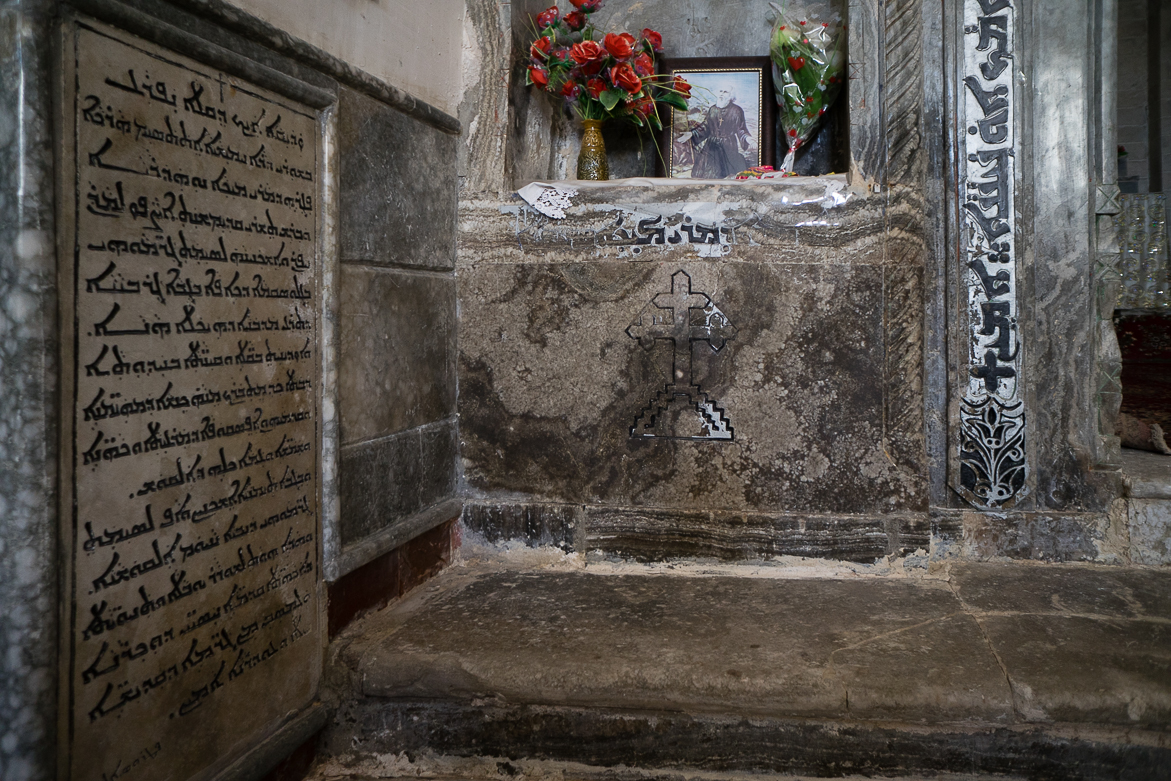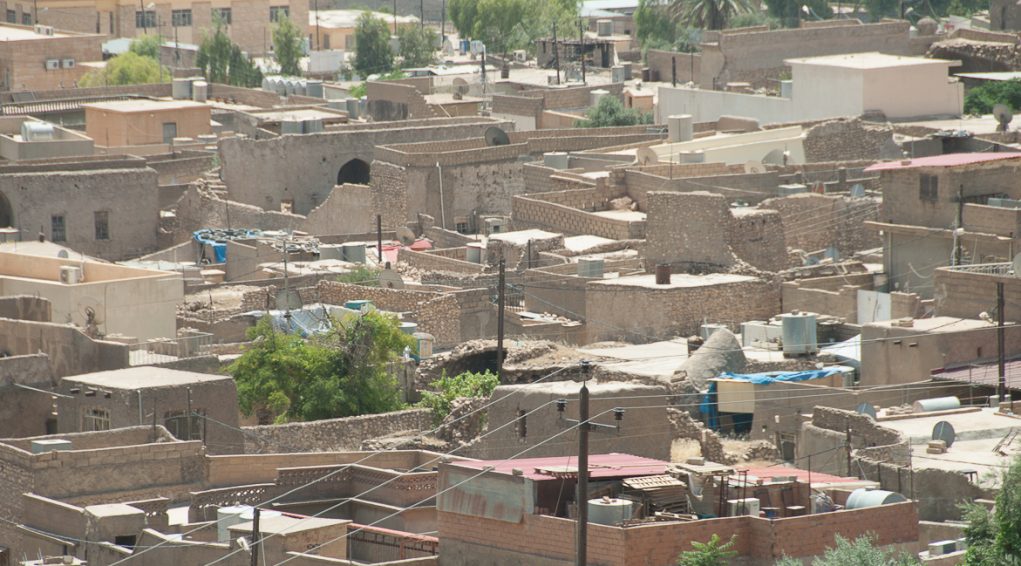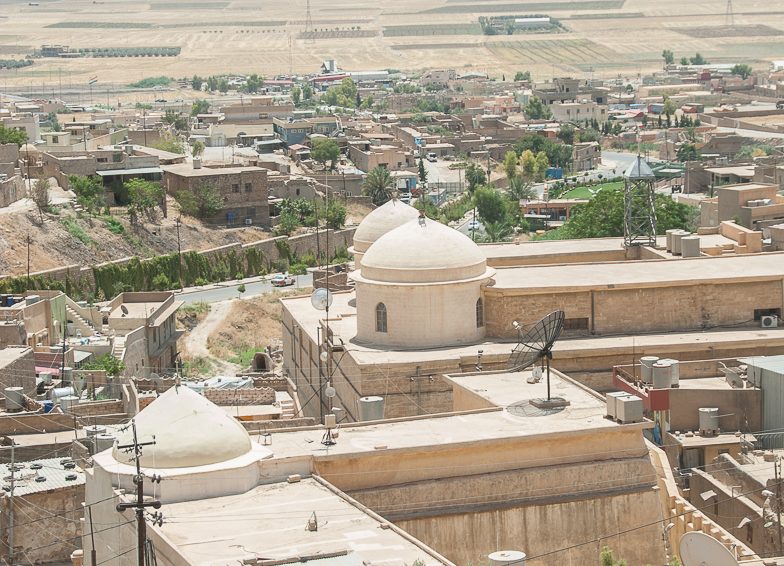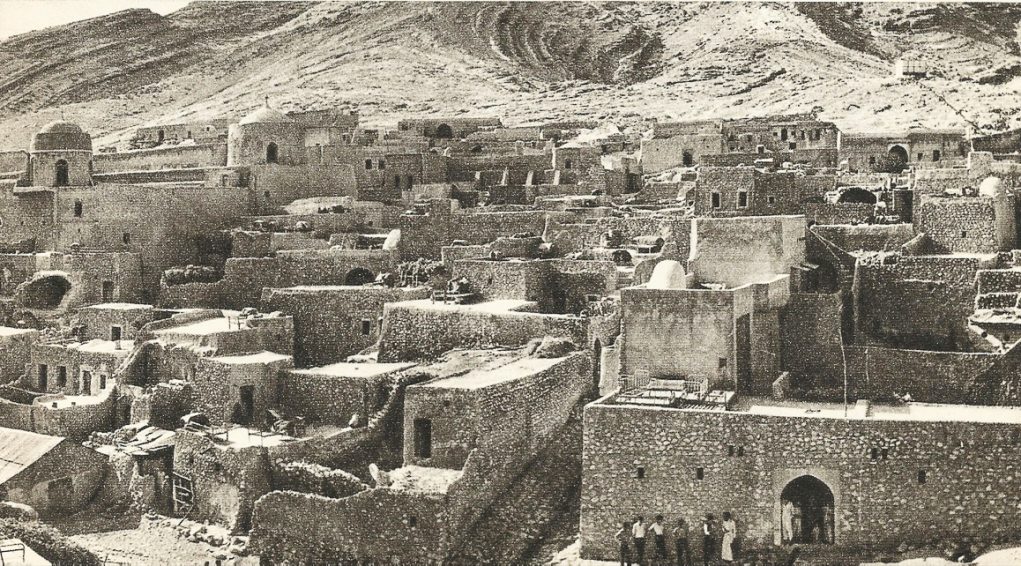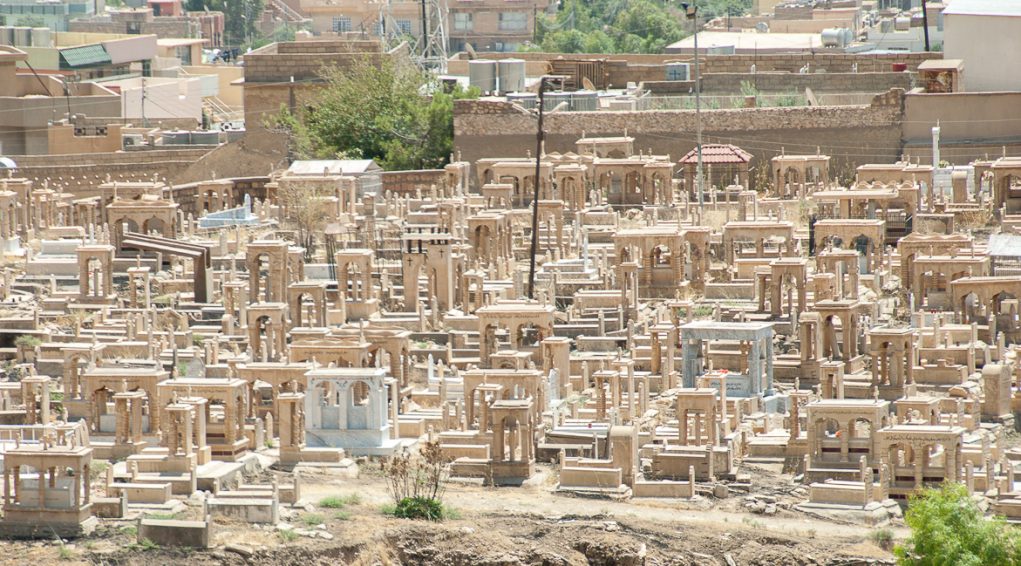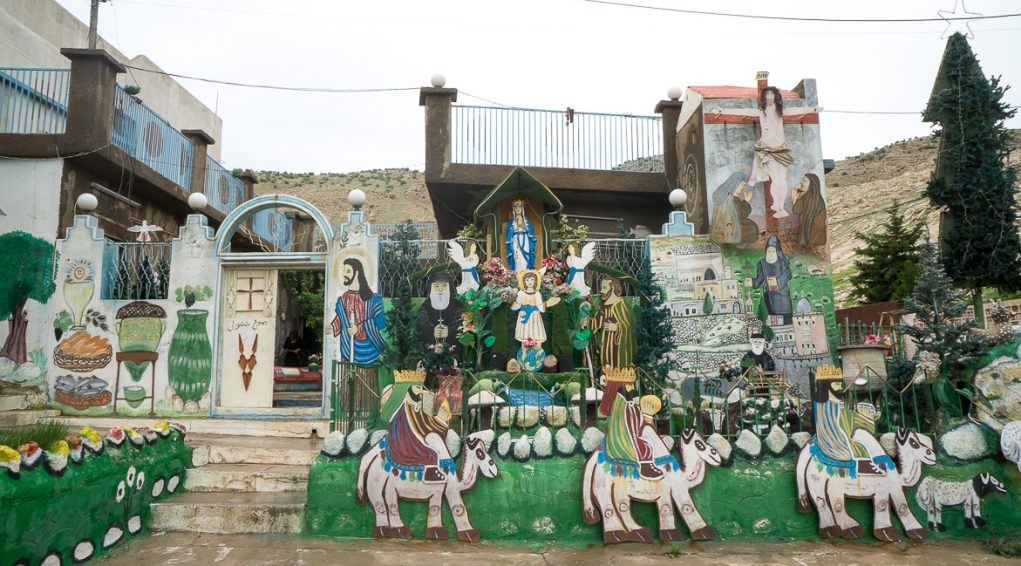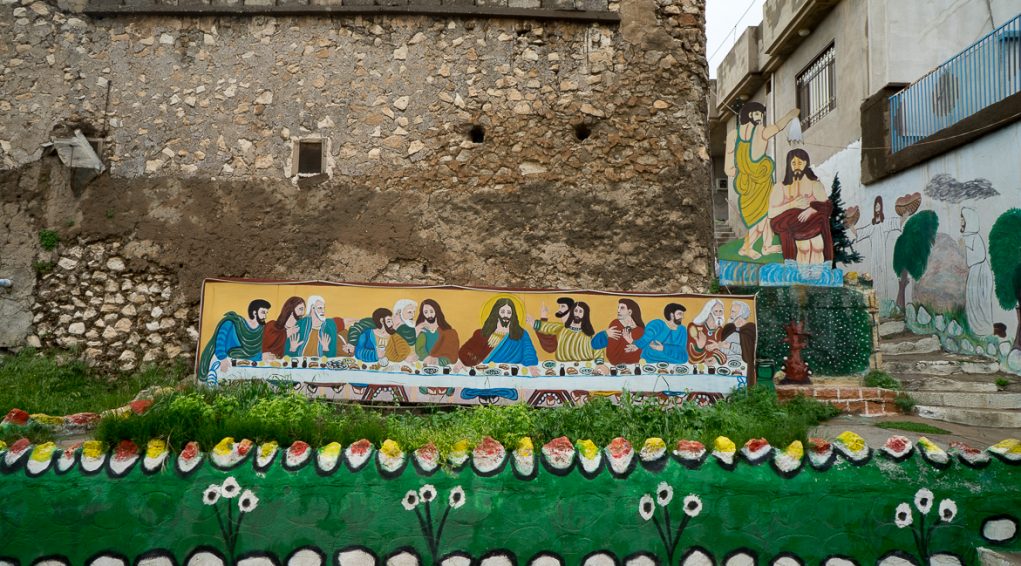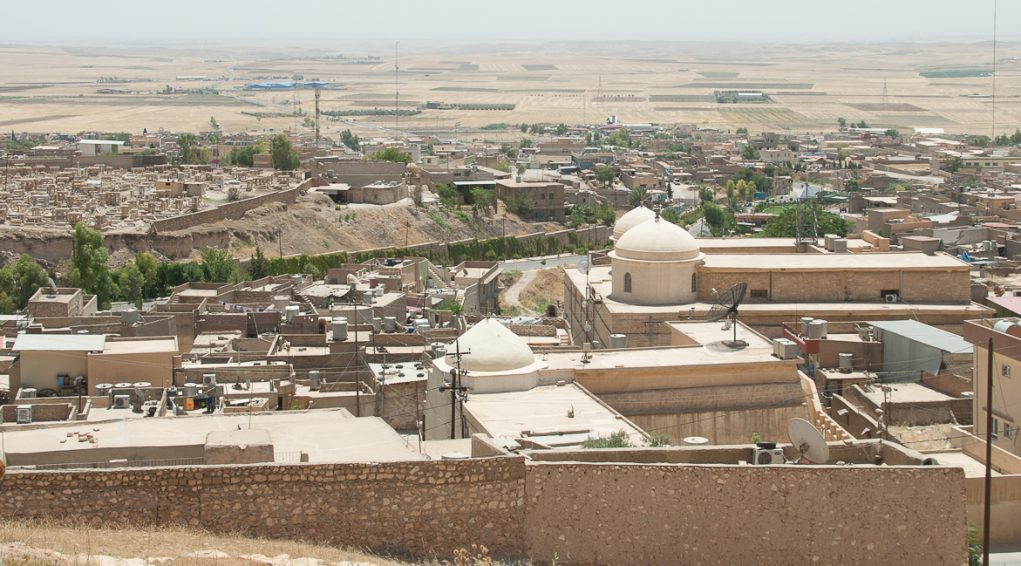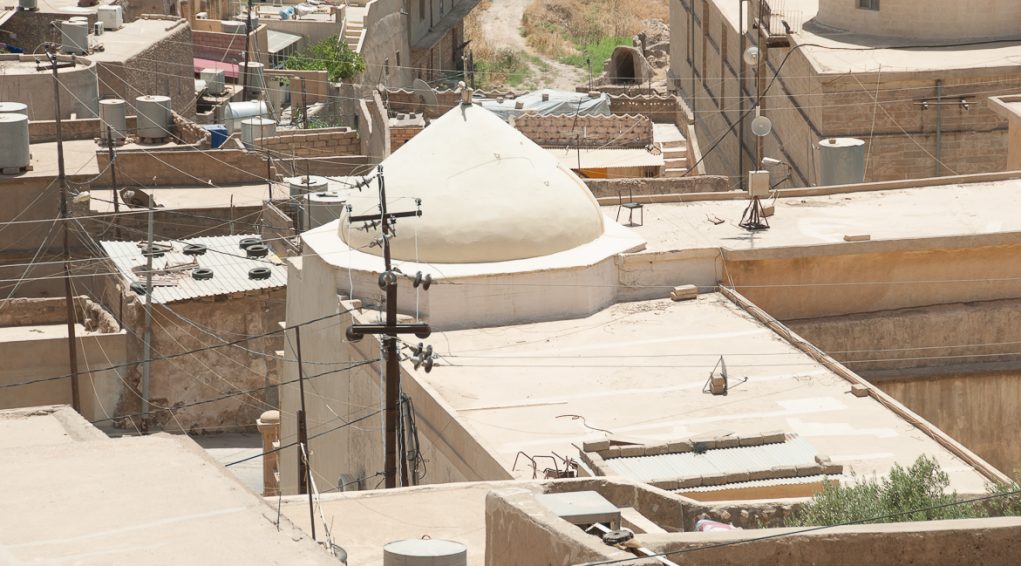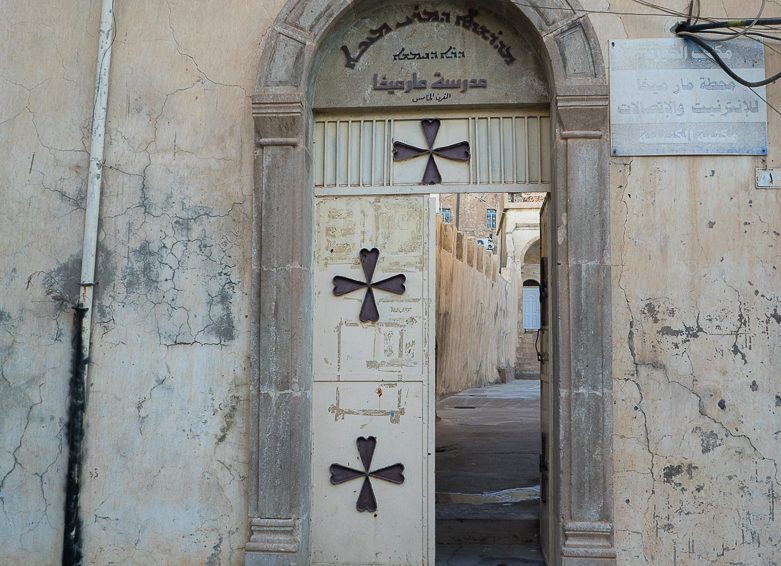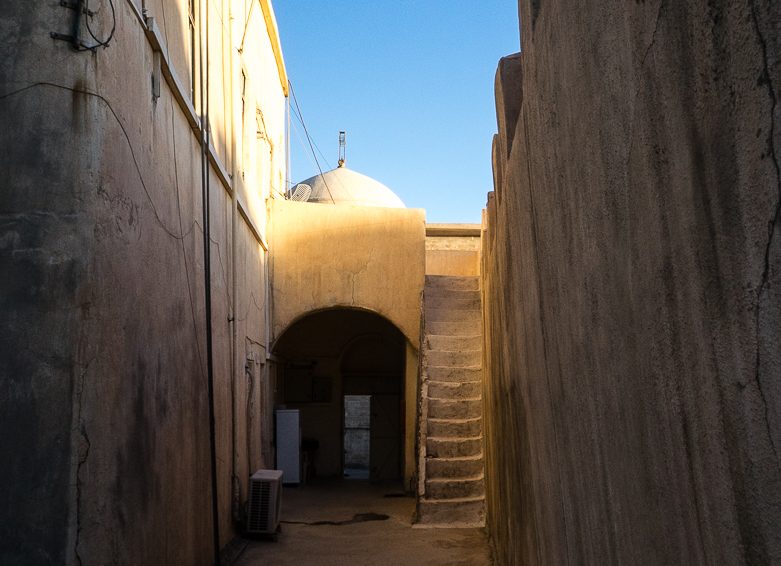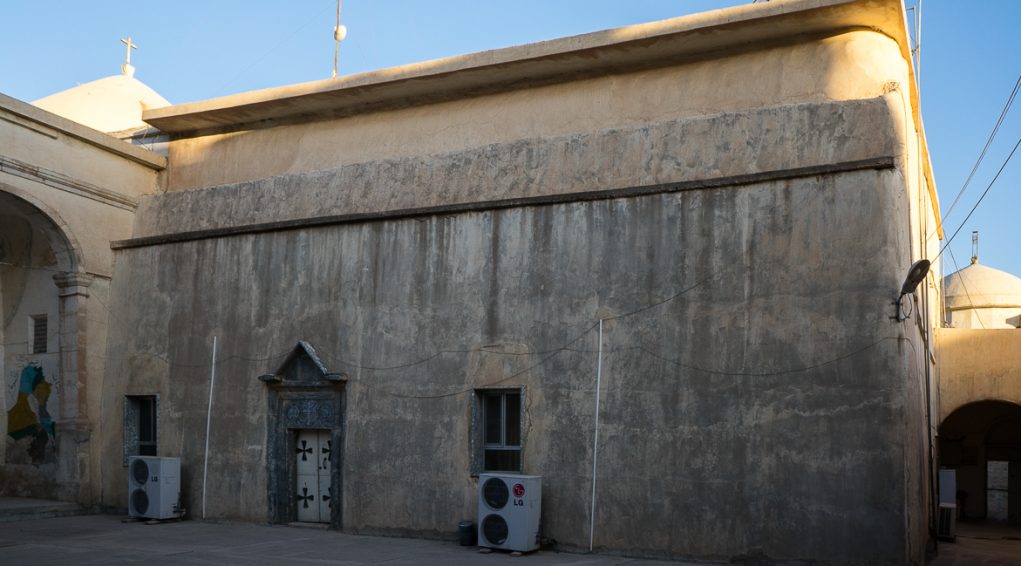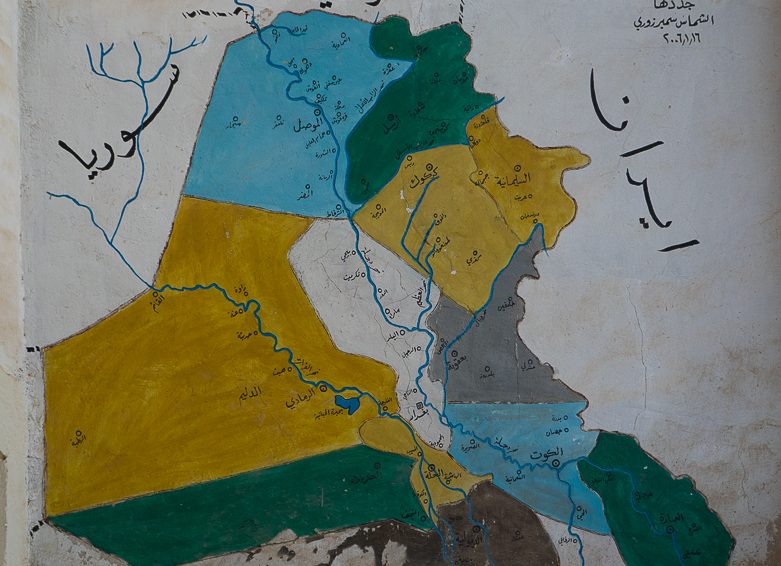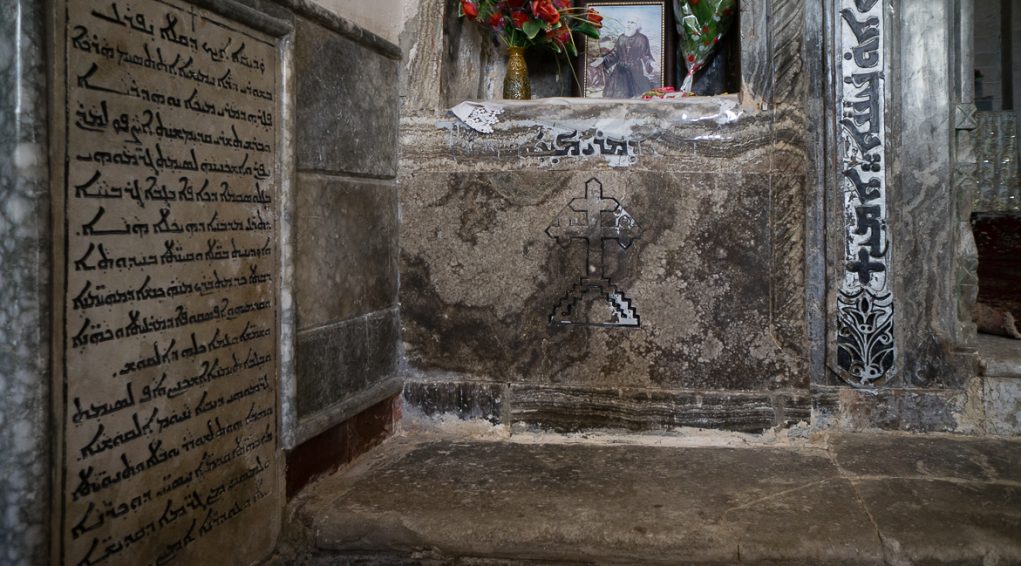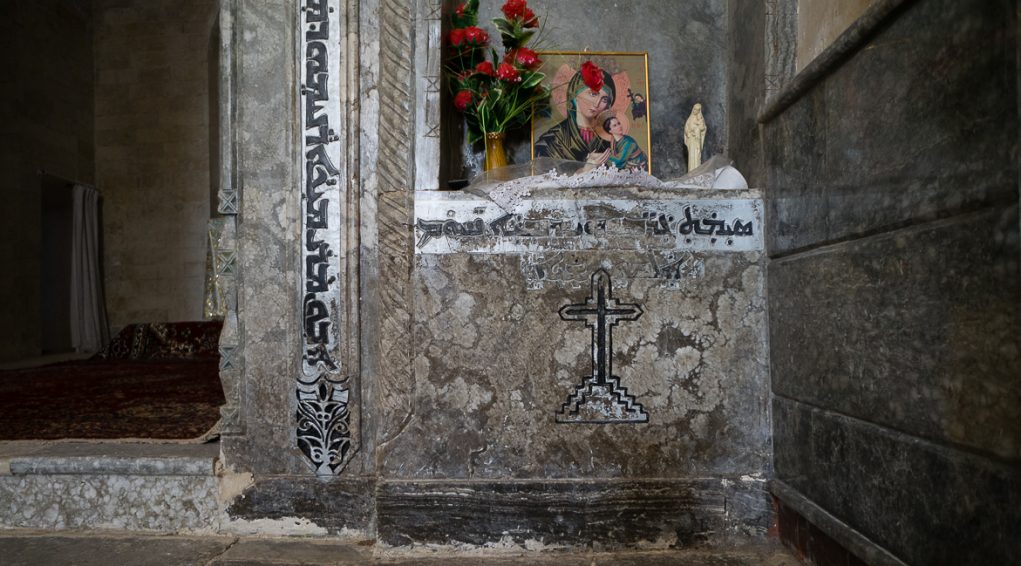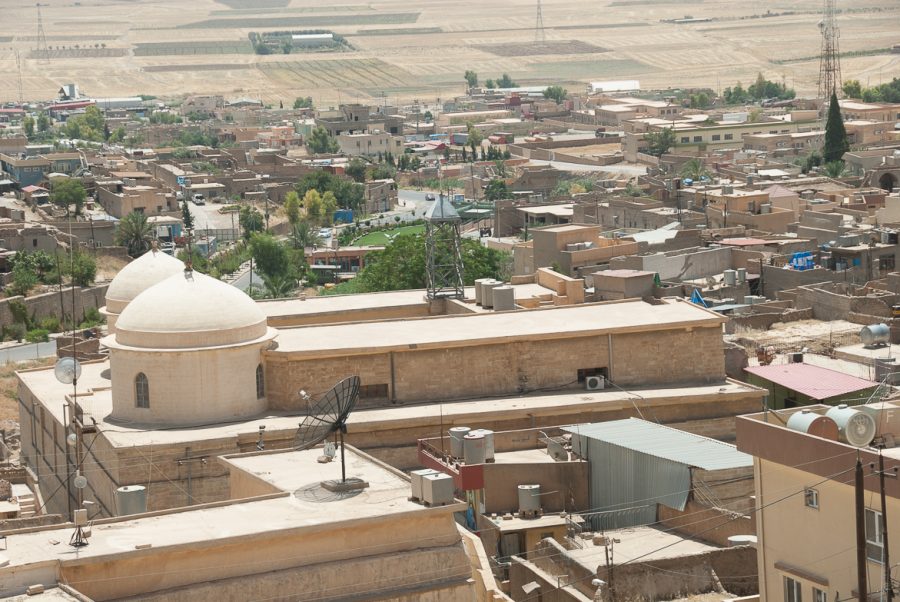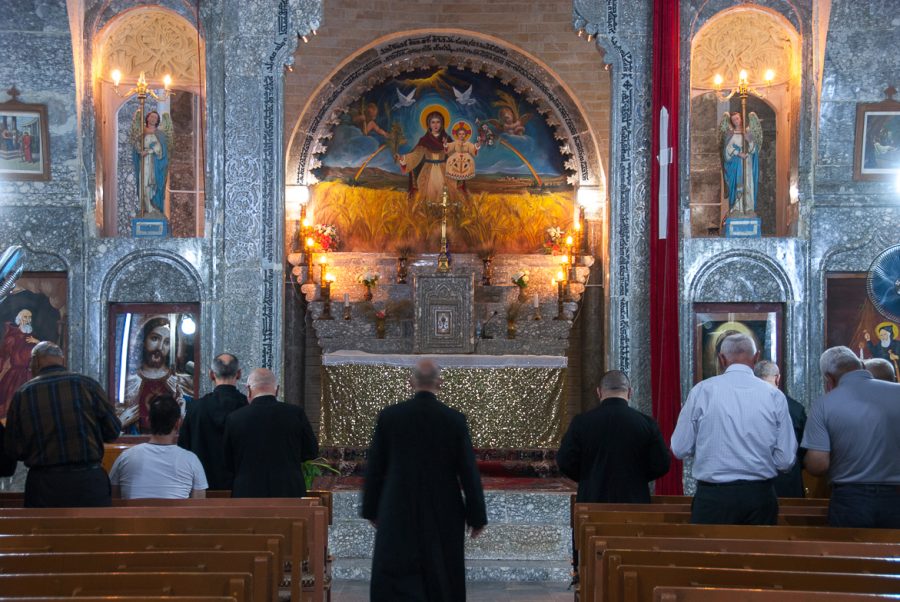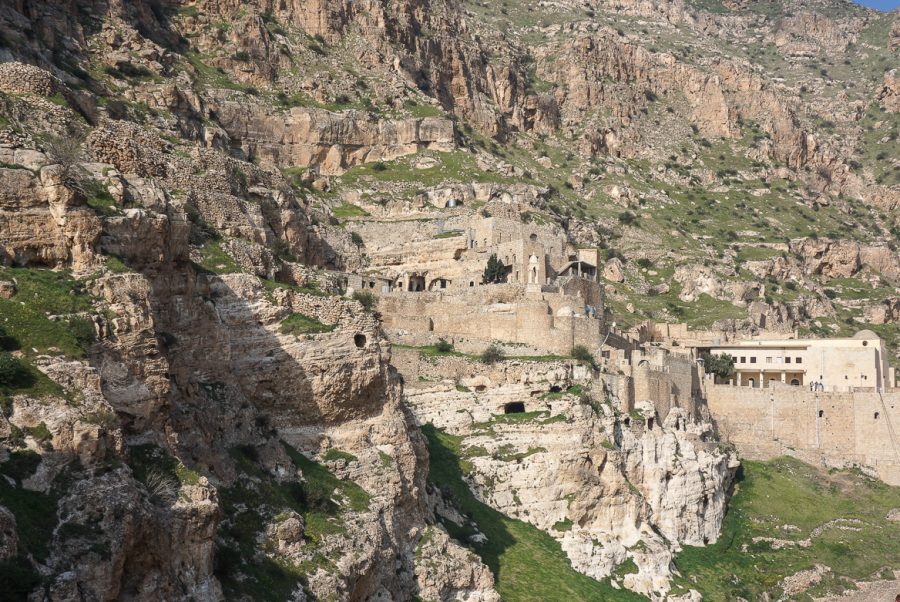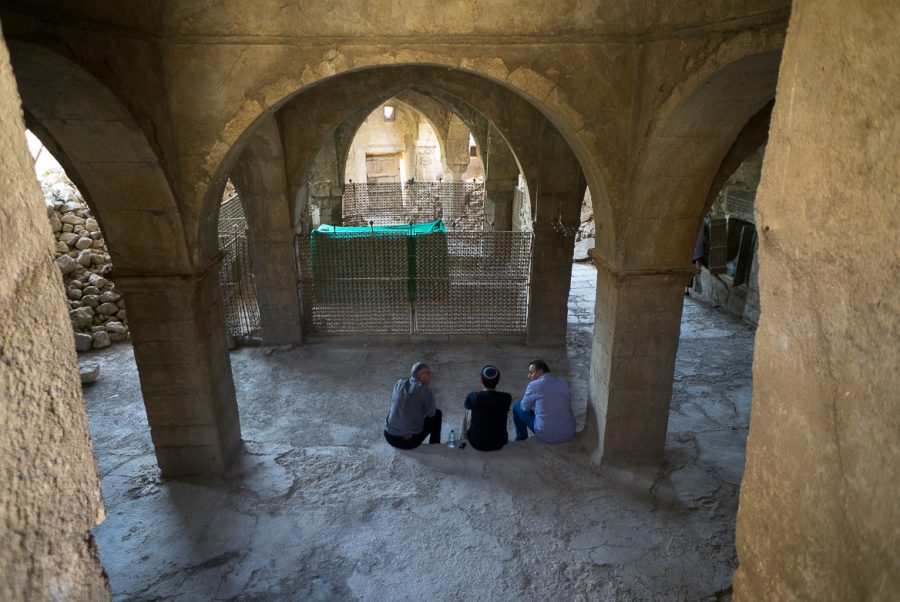The Church of Mar Mikha in Alqosh
Mar Mikha church in Alqosh lies 36°44’18.2″N 43°05’50.7″E and 562 meters high.
It is named after a famous 4th century saint, Mar Awgin (Saint Eugene), founding father of Syrian coenobitism.
The church which is said to host Mar Mikha’s relics is supposed to be one of the oldest churches in Alqosh.
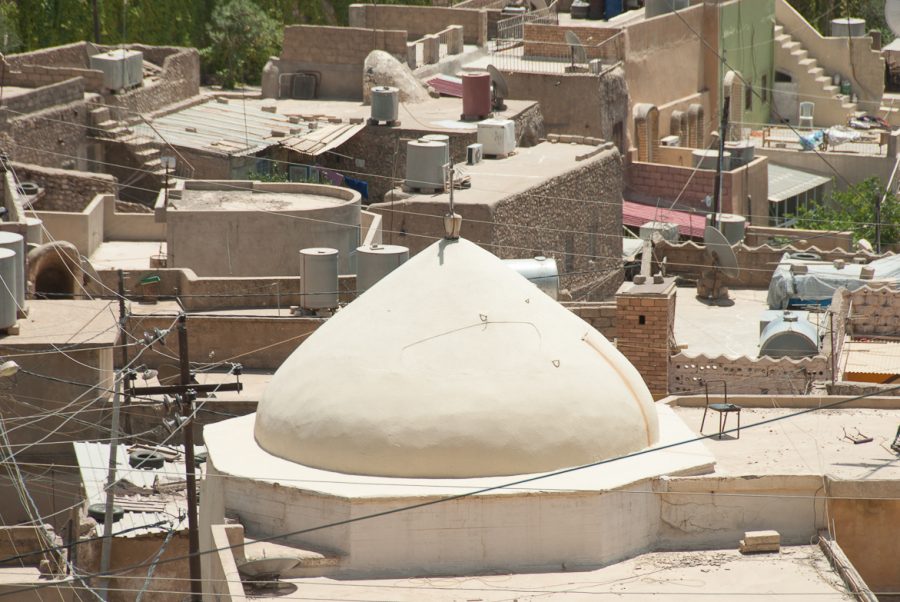
Mar Mikha is a single-naved church, at the eastern end of which stands a large royal gate made out of Mosul marble. The two most important elements of this construction are situated precisely there: in the building work of both pillars of this royal arch. At the bottom of the left pillar of the royal gate (when looking at the altar), there is on the wall a textbox with an inscription that indicates the place of Mar Mikha’s relics, in a “jar embedded in the building work”. On the other side of the gate, at the bottom of the right pillar, another textbox indicates the place of the prophet Nahum’s relics.
Location
40 kilometres north from Mosul and 10 km from the eastern bank of the Tigris river, Mar Mikha church lies 36°44’18.2″N, 43°05’50.7″Eand 562 metres high, at the northern end of the city of Alqosh, itself at the extreme northern part of the Nineveh province. To get to Mar Mikha church, you have to worm your way through the narrow alleyways in the old town centre.
Close to Mar Giwargis church, Mar Mikha church is 2 km away west from Rabban Hormizd Monastery and from the Monastery of our Lady of the Seeds.
A short Christian history of Alqosh
Alqosh[1]is known to be one of the most ancient Christian villages of northern Iraq. The first believers, who probably turned to Christianity as early as from the 1stcentury on, under the influence of the apostle Thomas, were probably issued from the local Jewish communities.
The Jewish origins of the city of Alqosh are often mentioned through different types of sources, and even in its name itself, as the Jewish Alqōnmeans “exiled there by the Assyrians[2]”. This Jewish parenthood is also reminded in the presence of the tomb of Nahum the Alqoshian and prophet of Nineveh, whose partially ruined mausoleum is very close to Mar Mikha church.
The Christian history of Alqosh is marked by a spiritual and intellectual intense influence, that kept spreading thanks to the great schools for copyists, poets and calligraphers, among them those from the Hōmo family in the 18thand 19thcentury. Alqosh produced generations of monks, illuminators and writers of a huge number of Syriac manuscripts, which contributed to the fame of Rabban Hormizd Monastery first and later of the Monastery of our Lady of the Seeds.
Besides, the Christian history of Alqosh is a long succession of plundering and never-ending destructions perpetrated by Mongol, Turkoman, Persian, or Kurd (…) fighters along the centuries and more especially in the 16th, 18thand 19thcentury. In 1832, the superior and reformer of Rabban Hormizd Monastery, the highly venerated Father Gabriel Dambo, was murdered by the soldiers of the Kurdish Emir Mohammad Pasha of Rawanduz, however, his memory is still nowadays piously venerated. To this armed scourge, we must also mention other types of calamities, such as the plage in 1828 or famine in 1879. Whatever disasters Alqosh has gone through, the population and its heritage managed to get over it, and Alqosh is still today a beacon for Iraqi Christianity.
A still visible exceptional Christian testament
From one century to the other, the demographic growth of Alqosh reveals the persistence of an exceptional Christian testament. In the 18thcentury, at the end of 1767, there were 500 Christian families in Alqosh, among them 100 were Chaldean Catholics[1]. A century later, in 1891, Alqosh was still a village with 1 000 inhabitants[2]. In the 20thcentury, the demographic boost was even more significant with 17 000 inhabitants in 1967[3]. At the beginning of the 21stcentury, in 2014, just before the life threatening actions by ISIS, there were still 15 000 inhabitants in Alqosh. Of course, the city was almost fully evacuated when the jihadist fighters made their way up to just a few kilometres away from the town’s gates (a few hundreds of people stayed in Alqosh), but now that the threat is gone, Alqosh has got back to its demographic power and enjoys renewed influence.
[1]In A chronicle of the Carmelites in Persia, vol II (lettre du 27 décembre 1767), p. 1262, Mgr Emmanuel Ballyet, Bishop of Babylon and first French Consul in Baghdad. Quoted by Jean-Maurice Fiey, in Assyrie Chrétienne, vol.II, p.390.
[2]In La Turquie d’Asie-Tome 2nd, Vital Cuinet, Paris, Ernest Leroux éditeur, 1891, p. 829.
[3]In L’Église de l’Orient,article in the review Vivante AfriqueN° 253 Nov-Dec. 1967-7.
Mar Mikha the Alqoshian
According to the tradition, Mar Mikha of Nuhadra was a disciple of Mar Awgin[1], Egyptian monk who founded in the 4thcentury the Syrian coenobitic monasticism, and whose name, shrine and memory are associated to one of the most ancient monasteries in Tur Abdin, in southeast modern Turkey, 40km from Nusaybin (Nisibe) and from where can be contemplated the endless horizon of the Mesopotamian plain.
The tradition relates that Mar Mikha was one fo the holy fathers of Alqosh in the 4th century, at a time when Christianity was already settled there. The very first church of Mar Mikha had been founded at that time to host its relics. The fame of the local saint was such that every family in Alqosh had to give the name “Mikha” to one of their baby boys.
[1]The tradition relates that Mar Awgin came along with 70 disciples. Did Mar Mikha of Nuhadra really among those 70 fellow travellers of Mar Awgin ?
The church of Mar Mikha: architecture and inscriptions
It is impossible for us to say what the very first sanctuary looked like. However, we know that “the ancient building had three naves. (…). It is in this church, that Father Gabriel Dambo sought refuge before he was murdered. His body were hosted there for 12 years before being moved to Rabban Hormizd[1]“.
The church was at first set under the Church of the East’s authority, but then passed under the Chaldean Church’s, like all other churches in Alqosh during the centuries right after the creation of the Chaldean Church in 1553. Rebuilt between 1578 and 1581, the modern building had been built from 1876.
The round-shaped dome of Mar Mikha church is easy to observe from the hill overlooking the city. The stone walls of the church and of the protective enclosure are coated with a lime plaster, creating a thick and basic insulating mantle. The building’s entrance is situated north of a small square where a house stands, ornamented with several religious paintings: Saint George riding a horse and slaying the dragon, the Sacred Heart of Jesus and the Immaculate Heart of Mary.
A modest cut stone door, pierced within the surrounding wall, opens to a passageway that runs along the church’s western facade. At the end of this passageway is the inner courtyard, where numerous of priests and monks were buried. The school of Mar Mikha and the church of Mar Mikha stand on each side of this courtyard.
High up on the northeast wall of the church, above a painted map of Iraq, an inscription in Syriac language indicates that Mar Mikha school was built and achieved in 1923, all costs paid by the bishop of Alqosh, under the pontificate of Pope Pius XI and the patriarcate of Emmanuel II, Catholic Chaldean patriarch of Babylon[2].
The church of Mar Mikha has a terraced roof at the eastern end of which stands a flattened cone-shaped dome. The church is exactly twice as high as the two levels of the opposite school building.
The church can only be accessed to by a unique marble door, with a lintel ornamented with carved crosses and topped by a mitre-shaped pediment.
Mar Mikha is a single-naved church, at the eastern end of which a large royal gate made out of Mosul marble. The two most important elements of this construction are situated precisely there: in the building work of both pillars of this royal arch. At the bottom of the left pillar of the royal gate (when looking at the altar), there is on the wall a textbox with an inscription that indicates the place of Mar Mikha’s relics, in a “jar embedded in the building work[3]”. On the other side of the gate, at the bottom of the right pillar, another textbox indicates the place of the prophet Nahum’s relics[4].
In 1891, Vital Cuinet reported that « the remains were secretly removed in 1883 overnight, and placed in a Christian church, without the Israelites knowing, so that they go on venerating an empty tomb[5].”In July 2017, an inhabitant from Alqosh, Louis Djeuma related in person what he had witnessed in 1976: “Nahum’s remains were taken out of the pillar, then placed in a bottle, then put back again in the pillar and embedded in the royal gate’s pillar, at the very same place it used to be before[6].”
Beyond the liturgical mission of this church, the holy relics that are venerated there are said to have rare curative properties as they are supposed to heal “little children from cough[7]”.
Mar Mikha feast day is on November 1st.
[1]In Assyrie chrétienne, vol.II, Jean-Maurice Fiey, p.395.
[2]English translation of the inscription in Recueil des inscriptions syriaques, Tome 2, Amir Harrak, éditions de Boccard. Réf. AO.01.09 : photo p. 189, texte p.418
[3]In Assyrie chrétienne, vol.2, Jean-Maurice Fiey, p.395
[4]See notice (J001) about the tomb of prophet Nahum
[5]Id.
[6]Video testimony by Louis Djeuma, inhabitant from Alqosh
[7]In Assyrie chrétienne, vol.2, Jean-Maurice Fiey, p.396.
Monument's gallery
Monuments
Nearby
Help us preserve the monuments' memory
Family pictures, videos, records, share your documents to make the site live!
I contribute
